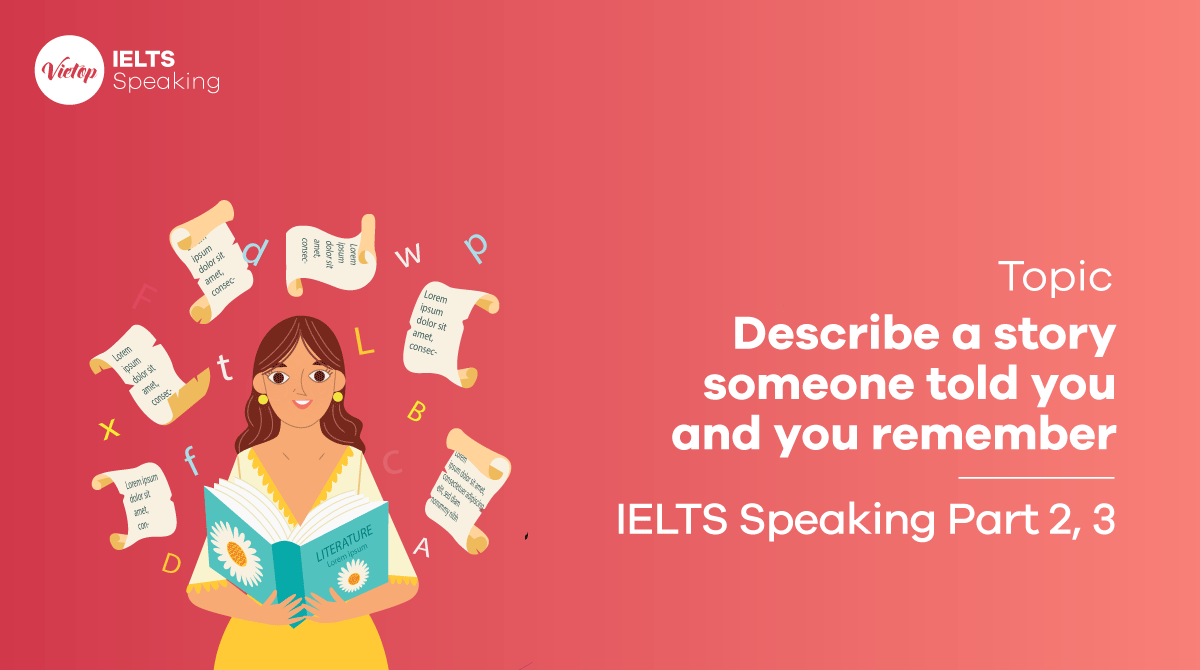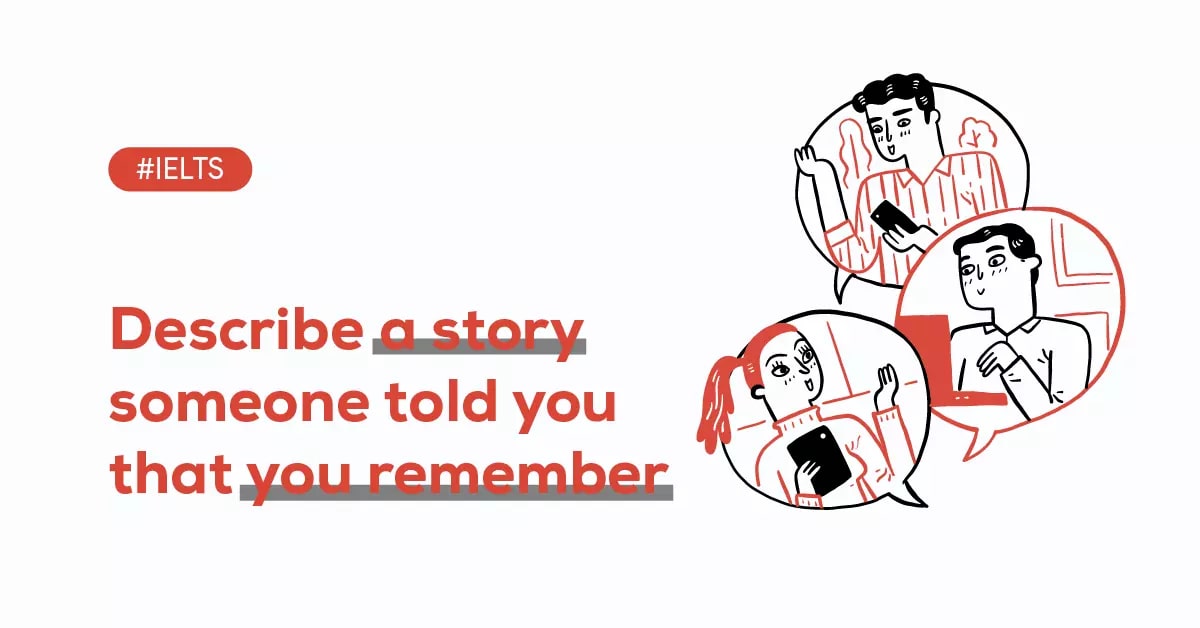Describe a story someone told you and you remember là một chủ đề thường gặp trong IELTS Speaking Part 2, chính thức xuất hiện trong đề thi ngày 03/04/2022 tại IDP Mạc Đĩnh Chi. Để giải quyết được tốt đề bài này, thí sinh cần chuẩn bị được vốn từ vựng và cấu trúc ngữ pháp liên quan đến nhóm chủ đề “Describe an experience (miêu tả trải nghiệm)”.
Hôm nay Vietop sẽ cung cấp cho bạn IELTS Speaking Part 2, Part 3 Sample: Describe a story someone told you and you remember.
IELTS Speaking Part 2 sample: Describe a story someone told you and you remember
| Describe a story someone told you and you remember. You should say: What was the story about Who told you this story Why do you remember it And explain how you felt about it. |

IELTS Speaking Part 2 sample
Let me share with you a folktale from my youth that I vividly recall.
It tells the tale of a boogeyman, also known as “Ong Ke” or “Ong Ba Bi” in Vietnamese, who kidnaps kids and takes them away in his sack. Nobody is sure of his origins or the destination to which he transports the unruly youngsters, but the children who disrespect and defy their parents are his main targets.
My mother told me this tale as she became irritated while feeding me with a spoon. You may recall that I used to be a picky child who preferred to play around rather than eat much. Like any Vietnamese mother at the time, I used the boogeyman narrative to frighten my children into eating and behaving well. Needless to say, when the majority of the kids heard about him, they were terrified, just like me.
It was an unforgettable childhood memory for me, so I still remember it. My mother had to take me around the neighborhood to get food for me. As a final option, she used the boogeyman to coerce me into eating the food. Although some people today might disagree, I used to believe that the boogeyman was the only thing that active youngsters like me would be terrified of. I feel happy every time I think about this tale.
So, that is all I have to say. I appreciate you listening.
Vocabulary Highlights
- Folktale (n): chuyện dân gian
- Vividly (adv): một cách sinh động
- Recall (v): nhớ lại
- Boogeyman (n): ông kẹ
- Kidnap (v): bắt cóc
- Sack (n): bao
- Origin (n): nguồn gốc
- Unruly (adj): ngỗ nghịch
- Disrespect (v): thiếu tôn trọng
- Defy (v): bất chấp
- Irritate (v): kích động
- Picky (adj): kén chọn
- Frighten (v): dọa sợ
- Needless to say: không cần nói rằng
- Coerce (v): ép buộc
Xem thêm:
Trả lời câu hỏi “What are you doing?” bằng tiếng Anh chi tiết
Lời chúc Wish you all the best: Ý nghĩa và cách dùng chi tiết
IELTS Speaking Part 3 sample: Describe a story someone told you and you remember

Has storytelling changed over a period of time?
Over time, storytelling has undergone changes. Historically, oral storytelling has mostly been utilized to pass on cultural beliefs and traditions from one generation to the next. However, narrative has developed in the modern era to encompass a range of mediums, including books, movies, television, and even video games. This has made it possible to tell stories in far more engaging and interactive ways and to a wider audience.
Additionally, the introduction of the internet has made it possible for tales to be shared and experienced in a way that is much more globalized. This allows stories to be shared across cultures and countries, making them more diverse and inclusive and allowing them to be told in a much more original and creative way.
- Oral storytelling (n): cách nói chuyện bằng miệng
- Narrative (n): chuyện kể
- Encompass (v): bao gồm
- Interactive (adj): mang tính tương tác
- Inclusive (adj): mang tính bao hàm
Do you think that generally, most people are good at storytelling?
I suppose that most people, on the whole, are decent storytellers. Since the beginning of time, telling stories has been a skill that has been passed down through the generations. It’s a talent that many individuals possess naturally and is embedded in our culture. A compelling and memorable approach to communicate ideas, emotions, and experiences is through the use of stories, which are an effective communication tool.
Furthermore, as storytelling enables us to share our experiences and tales with others, it can help people feel more connected to one another. As it may be used to communicate complicated ideas in a way that is simple to understand, storytelling can also be used to teach and inform. I think most individuals can tell a good narrative, and it’s a skill that can be improved and developed over time.
- Decent storytellers (n): người kể chuyện tài năng
- Pass down (v): truyền lại
- Embed (v): chìm
Xem ngay: Khóa học IELTS Speaking – Online và Offline cùng giáo viên IELTS 8.0+ Speaking
Is it important to tell stories?
Undoubtedly, storytelling plays a significant role in our lives. We may connect through stories, learn from one another, and comprehend our common experiences. Stories can be used to inspire, educate, and amuse people. They can also be used to convey culture, values, and beliefs. Using stories can help people connect with one another, develop empathy, and develop a feeling of community. The use of stories helps foster creativity and critical thinking.
We may sharpen our imaginations, learn to solve problems, and better grasp various points of view through engaging in storytelling.
- Comprehend (v): hiểu
- Inspire (v): truyền cảm hứng
- Empathy (n): sự đồng cảm
- Foster (v): nuôi dưỡng
- Grasp points of view: nắm bắt quan điểm
Hy vọng rằng qua bài viết này, bạn đã có thêm vốn từ vựng cũng như cấu trúc sử dụng cho dạng đề bài Describe A Story Someone Told You And You Remember. Bên cạnh về chủ đề IELTS Speaking Part 2, Part 3 Sample: Describe a story someone told you and you remember, bạn cũng có thể tham khảo thêm một số chủ đề khác thường hay gặp trong IELTS Speaking Part 2, Part 3 ở Vietop. Chúc bạn chinh phục IELTS thành công!
source https://www.ieltsvietop.vn/blog/describe-a-story-someone-told-you-and-you-remember/
Nhận xét
Đăng nhận xét